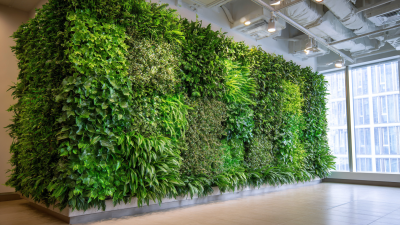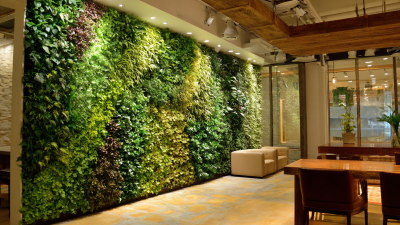As urban environments continue to expand, the demand for sustainable and aesthetic landscaping solutions has never been more pressing. One innovative approach that has gained traction is the implementation of Vertical Green Walls, which not only enhance the visual appeal of buildings but also contribute significantly to environmental sustainability. According to a report by the International Green Roof Association, incorporating green walls can lead to a reduction in energy costs by up to 30% and improve air quality by filtering pollutants and carbon dioxide. Additionally, a study from the University of Melbourne indicates that these vertical gardens can reduce surrounding temperatures by up to 4°C, providing vital heat regulation in densely populated areas. As we explore the myriad benefits of Vertical Green Walls in contrast to traditional landscaping solutions, it becomes evident that this modern technique not only elevates urban aesthetics but also plays a crucial role in fostering ecological resilience in our cities.

Vertical green walls are a revolutionary solution for urban environments, providing a multitude of benefits that traditional landscaping solutions often cannot match. One of the most significant advantages is their ability to maximize limited space. In densely populated cities, where horizontal ground space is at a premium, vertical structures can transform bare walls into lush gardens, contributing to the greenery quotient of urban landscapes without encroaching on valuable floor space.
Another critical benefit of vertical green walls is their positive impact on air quality. These living walls act as natural air filters, absorbing pollutants and carbon dioxide while releasing oxygen. This function is especially vital in urban areas plagued by high levels of pollution. Moreover, they help to mitigate the urban heat island effect by lowering surrounding temperatures, creating a cooler and more comfortable microclimate. The aesthetic appeal of these green walls also enhances the visual landscape, promoting mental well-being among city dwellers by offering a connection to nature in an otherwise concrete-dominated environment.
| Attribute | Vertical Green Walls | Traditional Landscaping |
|---|---|---|
| Space Efficiency | High | Low |
| Air Quality Improvement | Significant | Moderate |
| Thermal Insulation | Excellent | Average |
| Biodiversity Support | High | Low |
| Aesthetic Appeal | Contemporary | Traditional |
| Cost of Maintenance | Higher | Lower |
| Noise Reduction | Effective | Limited |
Vertical green walls have surged in popularity as a contemporary landscaping solution, presenting a striking alternative to traditional gardens. One primary advantage of vertical walls is their ability to enhance aesthetic appeal in urban environments, where space is often at a premium. According to a study by the International Green Roof Association, vertical gardens can increase property values by up to 15% while reducing energy costs by 25% through insulation. The lush greenery they provide not only beautifies spaces but also contributes to improved air quality and reduced urban heat islands.
In contrast, traditional landscaping solutions, such as expansive gardens and lawns, require more space and maintenance. While they offer a classic beauty, they often consume more water and resources. The U.S. Environmental Protection Agency notes that residential lawns contribute to over 30% of the total urban water usage. For homeowners seeking a balance between beauty and sustainability, vertical green walls are a viable option that marries aesthetics with ecological benefits.
**Tip**: Consider using native plants in your vertical garden to enhance biodiversity and minimize maintenance.
**Tip**: Incorporate a drip irrigation system to ensure efficient watering of your green wall, conserving resources while keeping your plants healthy and vibrant.

 Vertical green walls have emerged as a captivating alternative to traditional landscaping, offering unique aesthetic and environmental benefits. However, one critical aspect that potential adopters must consider is the maintenance required to sustain these systems. Unlike conventional gardens, which typically involve soil-based plants, vertical green walls can necessitate a different approach to upkeep. The maintenance effort may include routine watering systems, nutrient management, and periodic inspections to ensure the health of the plants.
Vertical green walls have emerged as a captivating alternative to traditional landscaping, offering unique aesthetic and environmental benefits. However, one critical aspect that potential adopters must consider is the maintenance required to sustain these systems. Unlike conventional gardens, which typically involve soil-based plants, vertical green walls can necessitate a different approach to upkeep. The maintenance effort may include routine watering systems, nutrient management, and periodic inspections to ensure the health of the plants.
Cost considerations also play a significant role when evaluating vertical green walls. Initial installation costs can be higher than traditional landscaping due to the need for specialized structures and irrigation systems. However, the long-term benefits might offset these costs, as green walls can improve energy efficiency in buildings, reduce air pollution, and enhance property value. Regular maintenance expenses, which could encompass plant replacement and technical support, should also be factored into the overall budget. As such, it is essential for property owners to weigh these variables carefully to make an informed decision regarding their landscaping approach.
The integration of vertical green walls in urban environments presents a compelling solution for enhancing sustainability amidst urban challenges. As cities continue to expand, the need for innovative strategies to mitigate urban heat islands and improve air quality becomes increasingly critical. Research indicates that vertical green systems can significantly reduce energy demands in buildings, offering potential energy savings of up to 30% in some cases. This not only improves energy efficiency but also positively impacts the overall carbon footprint of urban structures.
Tips: When considering vertical green walls, assess the type of plant systems suitable for your local climate to ensure optimal growth and longevity. Additionally, integrating rainwater harvesting systems with these green walls can enhance their effectiveness in stormwater management, addressing issues of urban runoff.
Moreover, green walls contribute to biodiversity and restoration of urban ecosystems. A recent study highlighted the importance of greenery in providing ecological benefits, such as improved habitat for pollinators and enhanced aesthetics in concrete-dominated landscapes. By adopting vertical greenery, urban planners and designers can effectively foster a healthier urban ecosystem while offering residents a connection to nature, even within densely populated areas.
Tips: For those looking to implement vertical green walls, consider using native plants that require less maintenance and irrigation, further supporting local biodiversity and resource conservation.
Vertical green walls are revolutionizing the way we approach space optimization in urban landscaping. Traditionally, landscaping solutions have primarily focused on horizontal surfaces, which can limit vegetation to the ground level and miss out on the potential of underused vertical spaces. By integrating greenery into walls, we not only enhance the aesthetic appeal of buildings but also maximize the available space, making it more functional and visually striking. This innovative approach provides a solution for areas where land is at a premium, particularly in dense urban environments.
Moreover, vertical green walls contribute to environmental sustainability by improving air quality and promoting biodiversity. These living walls can support various plant species, offering habitats for urban wildlife. They can be installed in indoor settings as well, where they help regulate temperature and humidity while creating a calming atmosphere. As urban planners and architects increasingly recognize the benefits of utilizing vertical surfaces for greenery solutions, we are likely to see a shift toward more sustainable and effective landscaping practices that prioritize both nature and space efficiency.










